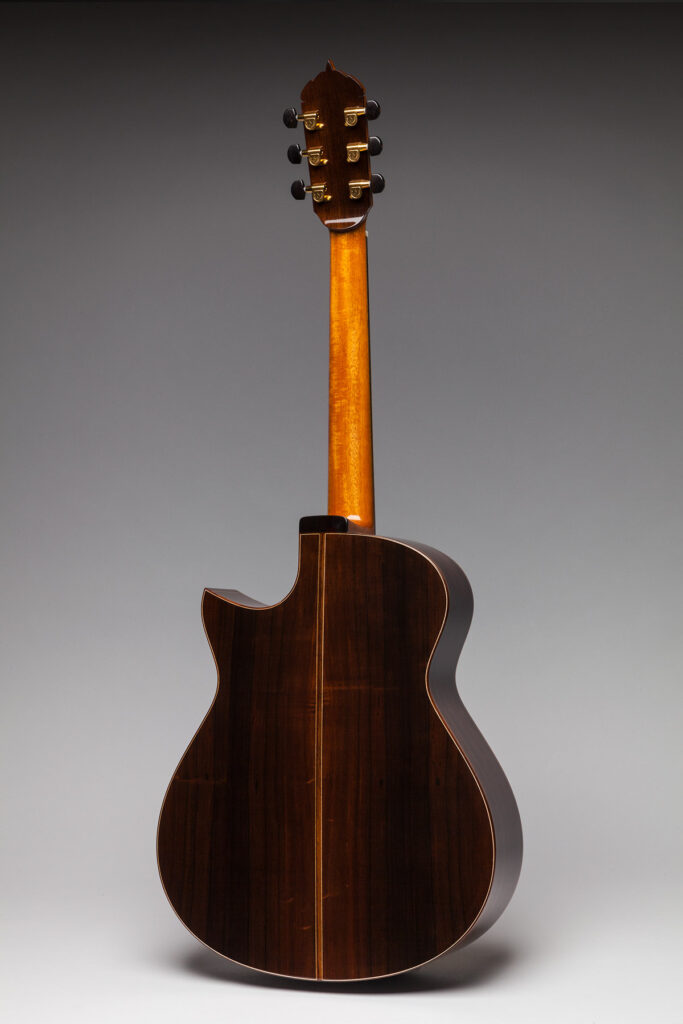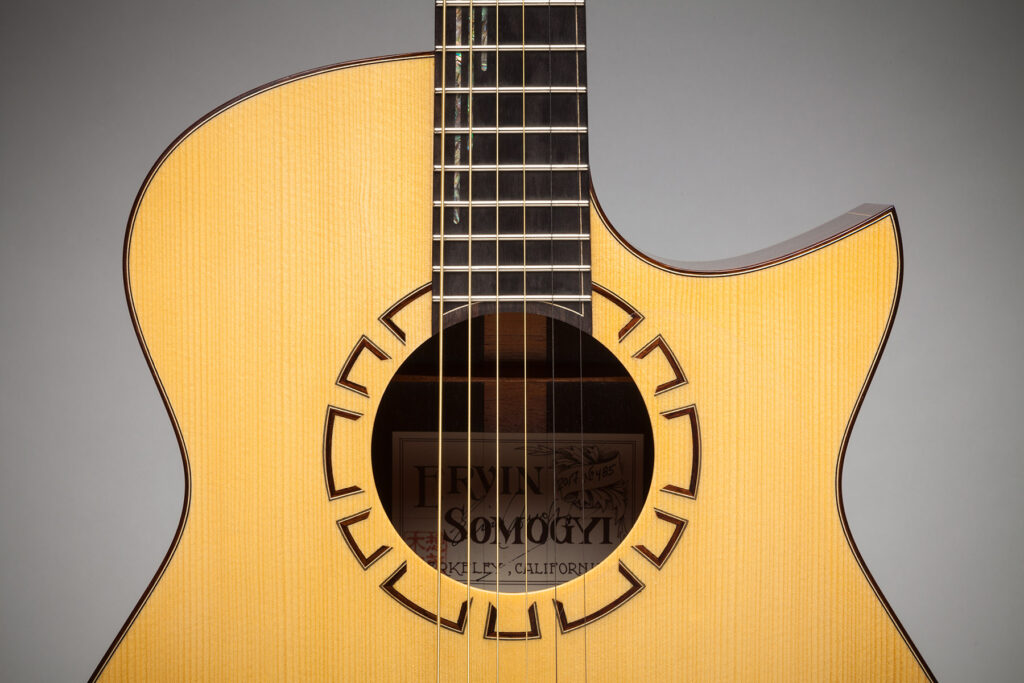Guitar No. 485 is a lovely OM model. For those of you who don’t know, the only difference between an OM guitar and a 000 guitar is that the neck of the former has fourteen frets to the body and the neck of the latter has twelve frets to the body. Besides player comfort, there’s a tonal implication of the location of the bridge.
If you are interested in knowing something about the guitar’s dynamics, I’m going to tell you about some of them. But if you’re not, please skip these next three paragraphs and go on to my descriptions of No. 485, below.
– – – – – – – – – – – – – – – – – – – – – <> – – – – – – – – – – – – – – – – – – – –
Dynamically, the bridge is the point of entry of the strings’ energies into the guitar top; the top gets excited at that point first. And if you can think of the guitar top being like a drumhead (which in fact it is) then you can appreciate that a drum would make a different sound depending on where you hit it with your drumstick. Just so with the guitar. With both the drum and the guitar one gets the best and fullest sound if one excites their respective membranes at their midpoints. No. 484 is a 14-fret guitar, in which the bridge looks off-center; it’s closer to the soundhole than to the bottom end. If it were a 12-fret guitar the bridge would be at the widest point of the lower bout, at what seems to be smack-dab in the middle of the guitar face, equidistant from the soundhole and the bottom edge of the guitar.
It ain’t so. It’s an optical illusion created by (1) the internal bracing structure and (2) a soundhole that is, by tradition, in the wrong place. The 14-fret guitar’s bridge is at the actual middle of the vibrating top, which extends from the bottom of the guitar to the upper edge of the soundhole. You can see in the photos that the bridge is the same distance from those two points. Consequently, even though this represents a vibrating membrane with a gaping hole in it, it gives you a stronger, louder, more energetic and present sound than the 12-fret guitar does. The 12-fret version, on the other hand, if it lacks the sheer power of its brother, produces a BEAUTIFUL sound that is warmer, gentler, more nuanced, and perfectly suited to playing in smaller rooms, instead of on a stage.
I learned this years ago when, having no one to otherwise guide me, I thought that I could improve the projection and power of my guitars by putting my bridges in what LOOKED like the active top’s midpoint . . . but didn’t sound as I’d expected. I still remember the happy shock my brain experienced when I put two and two together and came up with four and understood what I’d been doing! I’d been thinking that two plus two could equal five, if one could work with extremely large values of two . . . . . but I could never get that to work.
– – – – – – – – – – – – – – – – – – – – – <> – – – – – – – – – – – – – – – – – – – –
Guitar No. 485 has a European spruce top and straight-grained Brazilian rosewood back and sides, and mahogany neck and head.
It also has a unique “staple” rosette that is an offshoot of my “signature” segmented rosette – except that this version is trickier to execute because it’s so crisply outlined and detailed. Take a close look at it and you’ll see what I mean. And working at that level in spruce is tricky; the cuts have to be EXACT. It also has:
- A sculpted Brazilian rosewood bridge,
- Brazilian rosewood bindings, and peghead veneers,
- Ebony fretboard with linear abalone position markers,
- Clear plastic pickguard,
- French polish finish,
- Gold Schaller tuners with ebony buttons,
- Bone nut and saddle,
- Adjustable trussrod
This guitar is new. I had put it in the hands of a dealer a year ago, but for some reason his clientele weren’t attracted to it; so I got it back. I renewed the finish on it so that it both IS and LOOKS new. It has had no other owners, nor players.
And does it sound good? Yes; I really really really really think it does.
– – – – – – – – – – – – – – – – – – – – – <> – – – – – – – – – – – – – – – – – – – –
Write to me at shop@esomogyi.com for price, and any other information about this instrument that you would like to have. In the meantime, I wish all of you good health and equilibrium in this time of political and economic upheaval, and viruses.



